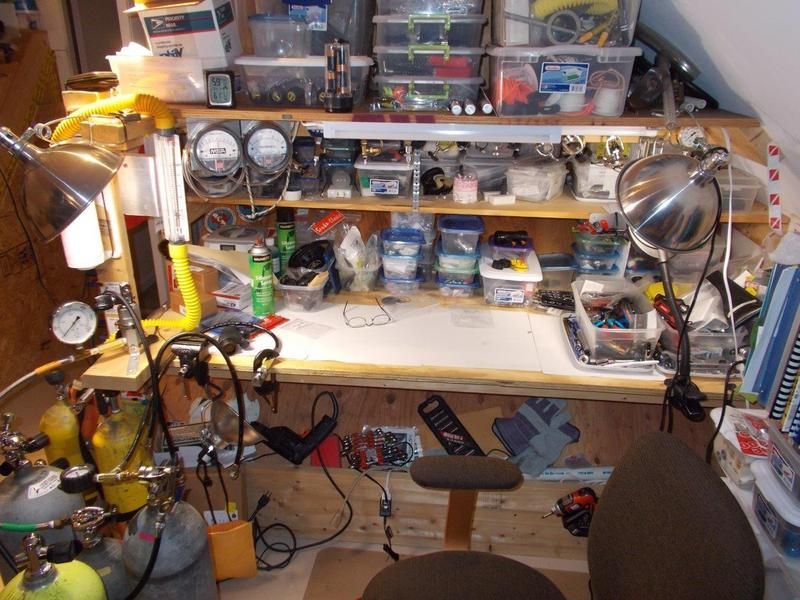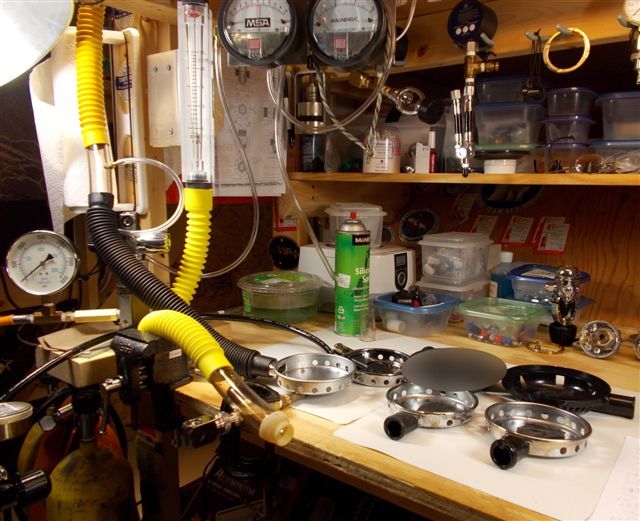Scubapro showed in their catalogs, valves with some kind of pressure indicator as early as 1962, but you can tell that the 1962 to 1964 catalogs are showing more of an artistic concept. The pressure indicator was also shown on the front of the valve in those sketches.
This particular valve with that exact handle and almost the exact valve showed up in the 1965 catalog. The only difference with what the catalog shows is the arrangement of the pressure numbers, but the rest of the valve is exactly as shown in the 1965 catalog.
We don’t have a 1966 scanned Scubapro catalog, therefore I don’t know if it was still there.
In 1967 the valves changed to the style that I am very familiar with since it was unchanged all the way through the 70’s and into the early 80’s. This Scubapro valves had the pressure indicator that read: F, 1/2, E (for Full, half, and Empty).
The reserve version of the 1967 valve had the adjustable reserve (either 300 psi or 600 psi). In the catalogs it read: “This allows the user to pre-select a 300 psi reserve for regular diving or a 600 psi reserve for repetitive dives, cave diving or other diving where an elongated reserve is advantageous.”
Cave diving with a J valve… I am not making this up. I don’t remember ever reading that portion of the earlier catalogs before. Great stuff.
The only change to these valves is in 1972 when Scubapro introduced the DCAR (Depth Compensated Adjustable Reserve) valve. This reserve mechanism could not only b adjusted from 300 to 600 psi, but it also had a small hole on the top that allowed the water pressure to push on the reserve piston to increase the reserve pressure, making it of 300 or 600 above ambient.
I have a couple of those DCAR valves and will always consider them some of the most interesting valves. A lot of thought went into the design of those valves. They had a lot of innovation.
Oh yeah, and at least in the 1972 catalog their reserve valve was still considered suitable for cave diving.
A few of notes:
Pressure gauges were around since before any of this valves were introduced and they were almost standard equipment in the 70’s.
Scubapro offered pressure gauges in their first 1962 catalog.
Scubapro never made a regulator without a pressure port, they also only made single hose regulators.
As Bob mentioned, the indicator was never intended to replace a SPG (submersible pressure gauge, or also know as a Sea View Gauge). It was just a pressure indicator for surface use only.
The fact that it is only shown with numbers in the 1965 catalog leads me to believe that they learned real quick how inaccurate that indicator was.
BTW, Scubapro also offered a type of SPG (at the end of a hose) that had protruding bar indicating pressure. I think the diver might have been able to touch it or could view it. It is in some of the 60’s catalogs and I have seen pictures of it.
All the catalogs that I am referring about are available for download from VintageDoublehose .com
This particular valve with that exact handle and almost the exact valve showed up in the 1965 catalog. The only difference with what the catalog shows is the arrangement of the pressure numbers, but the rest of the valve is exactly as shown in the 1965 catalog.
We don’t have a 1966 scanned Scubapro catalog, therefore I don’t know if it was still there.
In 1967 the valves changed to the style that I am very familiar with since it was unchanged all the way through the 70’s and into the early 80’s. This Scubapro valves had the pressure indicator that read: F, 1/2, E (for Full, half, and Empty).
The reserve version of the 1967 valve had the adjustable reserve (either 300 psi or 600 psi). In the catalogs it read: “This allows the user to pre-select a 300 psi reserve for regular diving or a 600 psi reserve for repetitive dives, cave diving or other diving where an elongated reserve is advantageous.”
Cave diving with a J valve… I am not making this up. I don’t remember ever reading that portion of the earlier catalogs before. Great stuff.
The only change to these valves is in 1972 when Scubapro introduced the DCAR (Depth Compensated Adjustable Reserve) valve. This reserve mechanism could not only b adjusted from 300 to 600 psi, but it also had a small hole on the top that allowed the water pressure to push on the reserve piston to increase the reserve pressure, making it of 300 or 600 above ambient.
I have a couple of those DCAR valves and will always consider them some of the most interesting valves. A lot of thought went into the design of those valves. They had a lot of innovation.
Oh yeah, and at least in the 1972 catalog their reserve valve was still considered suitable for cave diving.
A few of notes:
Pressure gauges were around since before any of this valves were introduced and they were almost standard equipment in the 70’s.
Scubapro offered pressure gauges in their first 1962 catalog.
Scubapro never made a regulator without a pressure port, they also only made single hose regulators.
As Bob mentioned, the indicator was never intended to replace a SPG (submersible pressure gauge, or also know as a Sea View Gauge). It was just a pressure indicator for surface use only.
The fact that it is only shown with numbers in the 1965 catalog leads me to believe that they learned real quick how inaccurate that indicator was.
BTW, Scubapro also offered a type of SPG (at the end of a hose) that had protruding bar indicating pressure. I think the diver might have been able to touch it or could view it. It is in some of the 60’s catalogs and I have seen pictures of it.
All the catalogs that I am referring about are available for download from VintageDoublehose .com







